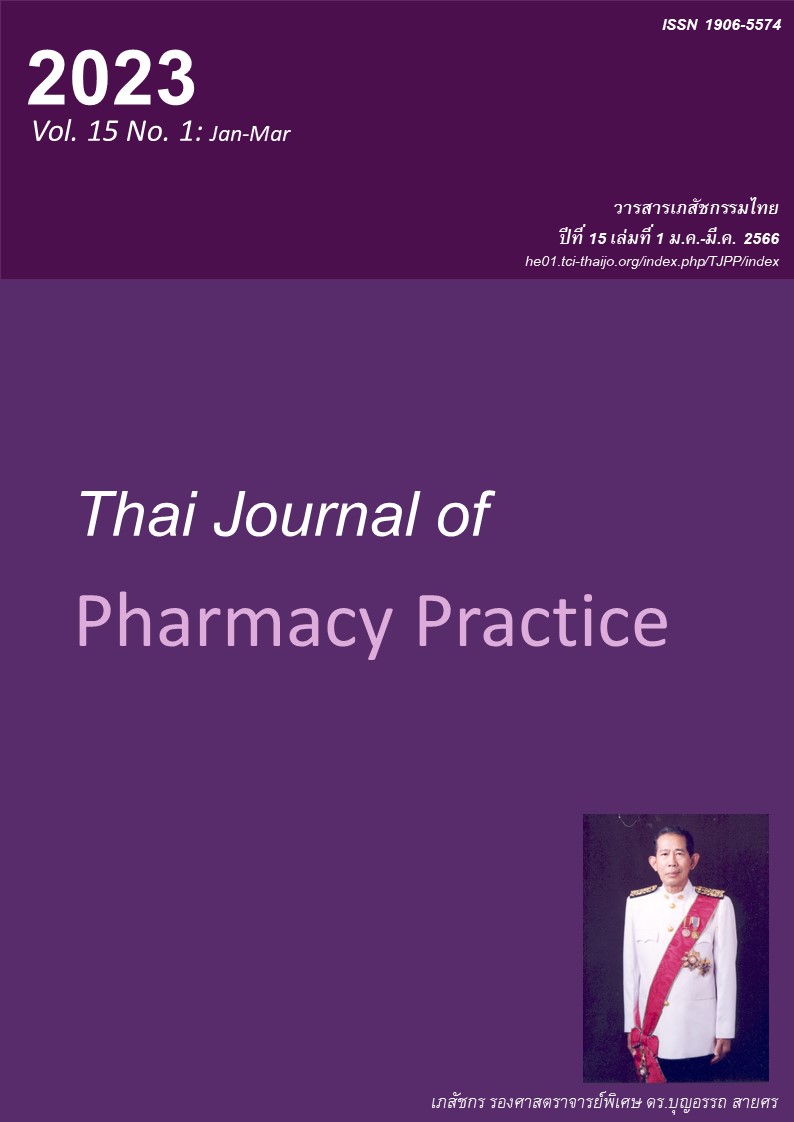การวิจัยและพัฒนาเครื่องมือเก็บตัวอย่างหลังโพรงจมูกสำหรับใช้ตรวจ โรคติดเชื้อจากไวรัสโคโรนาอย่างรวดเร็ว
Main Article Content
บทคัดย่อ
วัตถุประสงค์: เพื่อพัฒนาอุปกรณ์เก็บตัวอย่างสำหรับการตรวจ SARS-CoV-2 ที่สามารถเก็บตัวอย่างจากตำแหน่งที่เหมาะสมในปริมาณที่เพียงพอ และเพื่อทดสอบอุปกรณ์ดังกล่าวในห้องปฏิบัติการ วิธีการ: ขั้นตอนการวิจัยประกอบด้วยการทบทวนวรรณกรรมอย่างเป็นระบบ การระดมความคิดของผู้เชี่ยวชาญ การประดิษฐ์อุปกรณ์ และการทดสอบอุปกรณ์ในห้องปฏิบัติการ ข้อมูลจากการทบทวนวรรณกรรมและการระดมความคิดถูกรวบรวมและนำไปใช้ในการออกแบบอุปกรณ์ต้นแบบ หลังจากการทดสอบเบื้องต้นของอุปกรณ์แล้ว ข้อมูลที่รวบรวมได้ถูกส่งกลับไปยังผู้เชี่ยวชาญเพื่อตรวจสอบอย่างเป็นอิสระจนสามารถต้นแบบที่พร้อมที่สร้างขึ้น อุปกรณ์ดังกล่าวประดิษฐ์โดยผู้ผลิตอุปกรณ์ที่ผ่านการรับรองซึ่งมีความเชี่ยวชาญด้านการประดิษฐ์อุปกรณ์ภายใต้การดูแลและการตรวจสอบของวิศวกร การทดสอบในห้องปฏิบัติการโดยใช้อุปกรณ์ดังกล่าวทำกับแบบจำลองจมูกของมนุษย์ที่มีจมูก รูจมูก โพรงจมูก และไซนัส ผลการวิจัย: อุปกรณ์ต้นแบบ A สามารถเข้าถึงช่องหลังโพรงจมูกและเก็บตัวอย่างที่ต้องการได้ทั้งหมด ปริมาตรที่เก็บรวบรวมโดยเฉลี่ยของตัวอย่างคือ 1.71±0.25 มิลลิลิตรจากการจำลองการทดสอบ 100 รายการ สรุป: ผลลัพธ์ของการศึกษานี้เป็นเครื่องต้นแบบสำหรับเก็บตัวอย่างจากช่องหลังโพรงจมูกเพื่อตรวจหาเชื้อโควิด-19 ต้นแบบนี้ยังพร้อมที่จะผลิตและทดสอบในคลินิก
Article Details

อนุญาตภายใต้เงื่อนไข Creative Commons Attribution-NonCommercial-NoDerivatives 4.0 International License.
ผลการวิจัยและความคิดเห็นที่ปรากฏในบทความถือเป็นความคิดเห็นและอยู่ในความรับผิดชอบของผู้นิพนธ์ มิใช่ความเห็นหรือความรับผิดชอบของกองบรรณาธิการ หรือคณะเภสัชศาสตร์ มหาวิทยาลัยสงขลานครินทร์ ทั้งนี้ไม่รวมความผิดพลาดอันเกิดจากการพิมพ์ บทความที่ได้รับการเผยแพร่โดยวารสารเภสัชกรรมไทยถือเป็นสิทธิ์ของวารสารฯ
เอกสารอ้างอิง
Adil MT, Rahman R, Whitelaw D, Jain V, Al-Taan O, Rashid F, et al. SARS-CoV-2 and the pandemic of COVID-19. Postgrad Med J. 2021; 97: 110-6.
Yüce M, Filiztekin E, Özkaya KG. COVID-19 diagnosis-a review of current methods. Biosens Bio- electron. 2021; 172: 112752.
Alsharif W, Qurashi A. Effectiveness of COVID-19 diagnosis and management tools: a review. Radio graphy (Lond). 2021; 27: 682-7.
Yamayoshi S, Sakai-Tagawa Y, Koga M, Akasaka O, Nakachi I, Koh H, et al. Comparison of rapid antigen tests for COVID-19. Viruses. 2020; 12: 1420.
Liu T, Li N, Dong N. How to obtain a nasopharyngeal swab specimen. N Engl J Med. 2020; 383: e14.
US Centers for Disease Control and Prevention. Interim guidelines for collecting, handling and testing clinical specimens for COVID-19 [online]. 2020 [cited Sep 4, 2021]. Available from: www.cdc.gov/corona virus/2019-ncov/lab/guidelines-clinical-specimens.Ht ml?CDC_AA_refVal=https%3A%2F%2Fwww.cdc.go v%2Fcoronavirus%2F2019-ncov%2Fguidelines-clin ical-specimens.html.
World Health Organization. WHO guidelines for the collection of human specimens for laboratory diagnosis of avian influenza infection [online]. 2019 [cited Sep 4, 2021] Available from: www.who.int/in fluenza/human_animal_interface/virology_laboratories_and_vaccines/guidelines_collection_h5n1_humans/en/.
Chaimayo C, Kaewnaphan B, Tanlieng N, Athipan yasilp N, Sirijatuphat R, Chayakulkeeree M, et al. Rapid SARS-CoV-2 antigen detection assay in comparison with real-time RT-PCR assay for laboratory diagnosis of COVID-19 in Thailand. Virol J. 2020; 17: 177.
Nagura-Ikeda M, Imai K, Tabata S, Miyoshi K, Murahara N, Mizuno T, et al. Clinical evaluation of self-collected saliva by quantitative reverse trans- cription-PCR (RT-qPCR), direct RT-qPCR, reverse transcription-loop-mediated isothermal amplification, and a rapid antigen test to diagnose COVID-19. J Clin Microbiol. 2020; 58: e01438-20.
Torres I, Poujois S, Albert E, Colomina J, Navarro D. Evaluation of a rapid antigen test (Panbio™ COVID-19 Ag rapid test device) for SARS-CoV-2 detection in asymptomatic close contacts of COVID-19 patients. Clin Microbiol Infect. 2021; 27: 636.e1-636.e4.
Mak GCK, Lau SSY, Wong KKY, Chow NLS, Lau CS, Lam ETK, et al. Evaluation of rapid antigen detection kit from the WHO emergency use list for detecting SARS-CoV-2. J Clin Virol. 2021; 134: 104712.
Albert E, Torres I, Bueno F, Huntley D, Molla E, Fernández-Fuentes MÁ, et al. Field evaluation of a rapid antigen test (Panbio™ COVID-19 Ag Rapid Test Device) for COVID19 diagnosis in primary healthcare centres. Clin Microbiol Infect. 2021; 27: 472.
Bangkok Business online. Prepare to deliver 8.5 million 'Ag-RDTg' LEPU test kits, first lot on Sept 7 [online]. 2021 [cited Sep 4, 2021] Available from: www.bangkokbiznews.com/news/detail/957406
Denzler A, Jacobs ML, Witte V, Schnitzler P, Den- kinger CD, Knop M. Rapid comparative evaluation of SARS-CoV-2 rapid point-of-care antigen tests. Infection 2022; in press. doi.org/10.1007/s15010-022-01810-1
Sterne JAC, Savović J, Page MJ, Elbers RG, Blencowe NS, Boutron I, et al. RoB 2: a revised tool for assessing risk of bias in randomised trials. BMJ. 2019; 366: i4898.
Sterne JA, Hernán MA, Reeves BC, Savović J, Berkman ND, Viswanathan M, et al. ROBINS-I: a tool for assessing risk of bias in non-randomised studies of interventions. BMJ. 2016; 355: i4919.
Zeng X, Zhang Y, Kwong JS, Zhang C, Li S, Sun F, et al. The methodological quality assessment tools for preclinical and clinical studies, systematic review and meta-analysis, and clinical practice guideline: a systematic review. J Evid Based Med. 2015; 8: 2-10.
Nikolai O, Rohardt C, Tobian F, Junge A, Corman VM, Jones TC, et al. Anterior nasal versus nasal mid-turbinate sampling for a SARS-CoV-2 antigen-detecting rapid test: does localisation or professional collection matter? Infect Dis (Lond). 2021; 53: 947-52.
Morán Blanco JI, Alvarenga Bonilla JA, Homma S, Suzuki K, Fremont-Smith P, Villar Gómez de Las Heras K. Antihistamines and azithromycin as a treatment for COVID-19 on primary health care-a retrospective observational study in elderly patients. Pulm Pharmacol Ther. 2021; 67: 101989.


